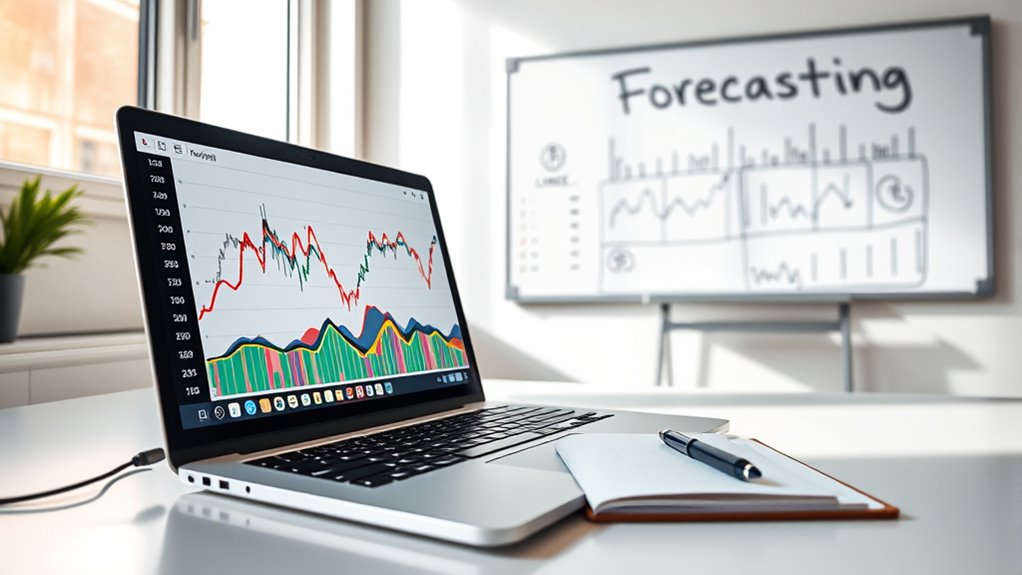Time-series forecasting with Prophet helps you analyze data that changes over time by modeling trends, seasonality, and irregularities. It enables you to identify patterns like recurring seasonal effects and detect anomalies, making your predictions more accurate and reliable. Setting up Prophet is straightforward and doesn’t require deep statistical expertise. By understanding how to prepare your data and optimize the model, you’ll be equipped to improve forecasts—keep exploring to learn how to get the most from this powerful tool.
Key Takeaways
- Prophet is a tool that simplifies time-series forecasting by automatically detecting seasonality and trends without requiring extensive statistical knowledge.
- It handles various data irregularities, such as missing values and outliers, to produce reliable future predictions.
- Setting up Prophet involves installing the library and preparing data with date and value columns for effective modeling.
- The model allows customization, including adding holidays and external regressors, to improve forecast accuracy.
- Visualizing forecast components helps interpret trends, seasonality, and anomalies, supporting informed decision-making.
Understanding the Basics of Time-Series Data

Understanding the basics of time-series data is essential before diving into forecasting techniques. Time-series data records observations over time, revealing patterns like trends and seasonality patterns. Recognizing seasonality helps you understand recurring fluctuations, such as increased sales during holidays. Data smoothing techniques are useful for reducing noise and highlighting underlying patterns, making it easier to analyze the data’s behavior. By smoothing data, you can better identify genuine seasonality patterns and trends, which are vital for accurate forecasting. It’s important to remember that time-series data isn’t just random; it contains structure that, once understood, can be modeled effectively. Understanding variability and consistency in data helps in selecting appropriate models and improving forecast accuracy. Grasping these foundational concepts allows you to make more informed decisions when applying forecasting models like Prophet.
Why Forecasting Matters in Business and Research

Forecasting helps you make smarter decisions by predicting future trends and demands. It also allows you to optimize resources effectively and plan ahead with confidence. Understanding why forecasting matters empowers you to stay competitive and adapt quickly to changing conditions. Additionally, utilizing advanced tools like predictive analytics can enhance the accuracy and reliability of your forecasts.
Informed Decision Making
Why does accurate prediction matter so much in business and research? It helps you make informed decisions by revealing underlying trends and seasonality patterns that influence outcomes. With reliable forecasts, you can anticipate demand fluctuations, optimize inventory, and allocate resources effectively. Recognizing seasonality patterns ensures your strategies align with regular cycles, reducing surprises. Additionally, forecasting enables you to identify anomalies early, facilitating anomaly detection and preventing potential issues from escalating. This proactive approach minimizes risks and boosts confidence in your planning. Informed decision making relies on understanding these patterns and anomalies, ensuring your business stays agile and competitive. Incorporating an understanding of energetic alignment can further enhance the effectiveness of your forecasting strategies. Ultimately, accurate predictions empower you to act confidently, seize opportunities, and mitigate threats before they impact your goals.
Resource Optimization Strategies
Accurate predictions are essential for optimizing resource allocation in both business and research settings. When you forecast demand effectively, you can improve inventory management, reduce waste, and guarantee resources are used efficiently. Proper forecasting allows you to anticipate fluctuations and adjust plans proactively. This minimizes stockouts and overstock situations, saving costs and increasing customer satisfaction. Additionally, it supports strategic planning by providing insights into future needs. By integrating forecasting tools like Prophet, you can refine your resource allocation processes and make data-driven decisions. To deepen your understanding, consider these aspects: Unique and Wicked Planters, improving inventory turnover rates, balancing supply chain demands, reducing operational costs, and enhancing decision-making accuracy.
Trend Identification and Planning
Understanding trends is essential for making informed decisions in both business and research. Trend analysis helps you identify patterns over time, guiding your planning and strategy. Recognizing these patterns lets you spot shifts early and adapt proactively. To visualize this, consider the following:
| Market Demand | Seasonal Fluctuations | Unexpected Changes |
|---|---|---|
| Steady growth | Holiday spikes | Sudden dips |
| Gradual decline | Weather impacts | Disruptions |
| Consistent trends | Promotions | Market shocks |
This table illustrates how pattern recognition reveals underlying trends, enabling better forecasting. By focusing on trend identification and planning, you can allocate resources wisely, optimize operations, and stay ahead of market shifts, making your decisions more data-driven and effective. Additionally, Kia Tuning techniques can be used to enhance vehicle performance, demonstrating the importance of precise adjustments based on trend data.
Key Concepts in Time-Series Analysis

Time-series analysis involves examining data points collected over time to identify patterns, trends, and seasonal variations. Recognizing seasonality patterns helps you understand recurring fluctuations, such as daily or yearly cycles. Detecting anomalies allows you to spot unusual events that deviate from expected behavior, which can be vital for troubleshooting or forecasting. You also need to contemplate stationarity, ensuring your data’s statistical properties remain constant over time. Additionally, understanding autocorrelation helps you see how current data points relate to past values, improving your model’s accuracy. Using vetted techniques can further enhance your analysis by ensuring reliability and robustness. These core concepts enable you to develop better forecasting models by capturing regular patterns, spotting irregularities, and understanding the underlying data structure. Mastering these ideas is fundamental for effective time-series analysis.
Exploring the Features of Prophet

Prophet is a powerful forecasting tool designed to simplify the process of modeling time-series data. Its model flexibility allows you to handle various types of data, including those with multiple seasonal patterns and irregularities. You don’t need extensive statistical knowledge to create accurate forecasts because Prophet automates key aspects of the modeling process. One of its standout features is automatic seasonality detection, which identifies and incorporates seasonal patterns like daily, weekly, or yearly cycles without manual intervention. This capability supports relationship dynamics by enabling more precise modeling of recurring patterns. Additionally, Prophet offers options to add custom holidays or events, further enhancing the model’s adaptability. Overall, these features enable you to develop robust, reliable forecasts with minimal effort.
Setting Up Your Environment to Use Prophet

To start using Prophet for your forecasting projects, you’ll first need to set up your environment with the necessary tools and libraries. Begin by installing Prophet via pip or conda, guaranteeing compatibility with your Python setup. Next, install data visualization libraries like Matplotlib or Plotly to analyze your forecasts visually. Consider setting up a virtual environment to manage dependencies efficiently, especially if you plan to deploy your model later. Also, prepare your environment for model deployment by installing frameworks like Flask or FastAPI, which facilitate serving forecasts in production. This setup ensures smooth integration from data visualization to deployment, making it easier to evaluate your models and share insights effectively. Proper environment setup streamlines your workflow and supports scalable, reliable forecasting. Additionally, understanding projector technology can help optimize your setup for better image quality and performance.
Preparing Your Data for Forecasting

Before building reliable forecasts, you need to prepare your data properly. Start by examining your time series for seasonal patterns, which are regular fluctuations that recur at specific intervals. Recognizing these patterns helps Prophet capture recurring trends more accurately. Next, perform anomaly detection to identify outliers or irregular data points that could skew your results. Correct or remove these anomalies to ensure cleaner input data. Consistent time intervals are essential; fill gaps or resample data as needed. Also, check for missing values and address them appropriately. Properly prepared data that reflects true underlying patterns and free of anomalies makes your forecasts more accurate and robust. Additionally, understanding the breast cancer symptoms within your dataset can help identify relevant features that influence your forecast accuracy. This careful preprocessing sets a strong foundation for successful time-series modeling with Prophet.
Building and Training Your First Prophet Model

Once your data is properly prepared, you can start building and training your first Prophet model. Begin by importing the library, creating a Prophet instance, and fitting it to your data. Use data visualization to understand trends and seasonality, guiding your model tuning decisions. Adjust parameters like seasonality modes or changepoint priors to improve performance. Key steps include:
- Initializing the Prophet model with default settings
- Fitting the model to your historical data
- Visualizing the fit and forecast components
- Experimenting with model tuning for better accuracy
- Recognizing the importance of model interpretability to effectively communicate your forecasts.
This process helps you grasp how Prophet captures patterns in your data, setting the foundation for more refined forecasting. Proper visualization and tuning enable you to develop a robust, accurate time-series model.
Evaluating and Improving Forecast Accuracy

After fitting your Prophet model, evaluating its accuracy becomes essential to guarantee reliable forecasts. You should check how well the model captures seasonality patterns and overall trends by comparing predictions with actual data. Use metrics like Mean Absolute Error (MAE) or Root Mean Squared Error (RMSE) to quantify accuracy. Analyzing residuals can help identify anomalies or unusual data points, which may indicate issues with the model or data quality. Incorporate anomaly detection techniques to spot outliers that skew forecasts. Adjust your model by tuning parameters or including additional regressors if needed. Continually refining your approach ensures your forecasts remain robust and dependable, especially when seasonality patterns change or unexpected anomalies occur. Additionally, understanding divorce processes in different states can provide insights into regional variations that may influence local data trends and model performance.
Practical Applications and Next Steps

Practical applications of Prophet span various industries, helping businesses and analysts make data-driven decisions with confidence. You can leverage it for predictive maintenance, identifying equipment failures before they occur, or optimizing inventory levels. In social media analytics, Prophet helps forecast engagement trends, allowing you to plan campaigns effectively. To maximize its potential, consider these next steps:
- Integrate Prophet with real-time data streams for timely insights
- Customize models to account for seasonal patterns and external factors
- Combine Prophet forecasts with other machine learning tools for enhanced accuracy
- Continuously evaluate and refine your models based on new data and performance metrics
- Be aware of support hours and scheduling considerations for tools and services used in your workflow.
Frequently Asked Questions
How Does Prophet Handle Seasonality and Holidays?
You want to understand how Prophet handles seasonality modeling and holiday effects. Prophet automatically captures seasonal patterns like daily, weekly, and yearly cycles, making it easy to model complex seasonality. It also allows you to include holiday effects, which can cause unique spikes or drops in your data. By incorporating these, Prophet improves forecast accuracy, especially around holiday periods, helping you better anticipate fluctuations driven by seasonal and holiday influences.
Can Prophet Be Used for Multivariate Time Series?
Imagine juggling multiple balls, each representing different variables—this is your multivariate challenge. Prophet primarily handles univariate data, making it less suited for multivariate time series directly. However, you can use multivariate techniques to preprocess and incorporate multiple signals into a univariate series. While Prophet can’t directly manage multivariate data, combining it with other methods allows you to address complex, multi-variable patterns effectively.
What Are Common Pitfalls in Time-Series Forecasting?
When you’re forecasting time series, watch out for common pitfalls like data leakage, which can give you overly optimistic results, and overfitting, where your model captures noise instead of true patterns. These issues lead to poor generalization on new data. Always guarantee your training data is properly separated, and avoid overly complex models. Validating your results with out-of-sample data helps prevent these pitfalls and improves forecast accuracy.
How Do I Interpret Prophet’S Forecast Components?
Imagine you’re analyzing sales data with Prophet. To interpret its forecast components, focus on trend analysis to see overall growth or decline patterns. Check residual diagnostics to identify any irregularities or seasonality effects not captured by the model. This helps you understand how well the forecast fits your data, enabling you to make informed decisions and refine your model for better accuracy.
Is Prophet Suitable for Real-Time Forecasting Applications?
You might find Prophet suitable for real-time forecasting, but it depends on your needs. Prophet offers relatively quick updates, enabling near real-time forecasts, which is handy for many applications. However, its forecast latency can vary based on data size and complexity. If low latency and frequent real-time updates are critical, you may need to contemplate additional optimizations or alternative tools designed specifically for live data streaming.
Conclusion
Now that you’ve learned the fundamentals, you’re ready to open insights, make informed decisions, and drive innovation. With Prophet, you can visualize trends, anticipate changes, and transform data into action. Embrace the power of forecasting to guide your business and research forward. Trust in your skills, refine your models, and never stop exploring. Your journey into time-series forecasting begins now—empower yourself to predict, improve, and succeed.









